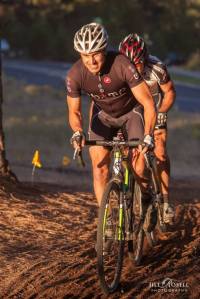A lot of hype concerning the difference between fitting a road bike and a cyclocross bike could be cleared up if we all agree on two simple things: put the engine in the right place, and then adjust for handling and comfort. Let’s break this down.
Saddle position
Your pedals are driven by large muscles surrounding the trunk, hips and knees. In fact, about 98.8% of the force you deliver to the pedals comes from your hips and knees. That’s right, the ankle only produces a very small percentage of your total power. So it makes sense to have the saddle height and setback (also called for-aft position) the same between your road and cross bikes to maximize power production. Why would you select a saddle position that compromises power output? Keep it simple. If you like your current saddle placement on your road bike, there is zero reason to change it on your ‘cross bike.
Handling and comfort

Good bar position allows you to move around while properly weighting the front end for corners and technical terrain | Photo © Jill Rosell Photography
Okay, now here’s where things are a bit different. Instead of rolling your slick tire down fresh asphalt, you’ve got to contend with dusty pumice, wet grass, rocks, roots, and the nutrient ‘crossers crave: mud! In short, it’s critical to have a good handling front end. This means that you want to have a little less weight on the front so that you can lift your front end over obstacles easier. Careful though, too little weight on the front end will bring your torso too upright make it hard for your front tire to bite and send you skittering wide towards the outside of the turn. Let’s see how this all plays out in fit.
- ‘Cross bikes typically have a higher bottom bracket. If you were smart, you’d kept your saddle in the same place as your (properly fitted) road bike. This means that your saddle is higher in the air than your road bike. Since your saddle is higher, your handlebars also need to be higher.
- Hand-grip placement for optimal handling: A lot of people rarely use their drops on their road bike. Then when on the ‘cross course, they find that they are forced into the drops on steep downhills to brake and get a better grip on the front end. Most riders find the bike is much more stable when conditions get squirrely if they use the drops. So if you are going to be in the drops, make sure you are comfortable.
So what’s the secret recipe to make sense of it all?
It’s simple really; the goal is to get the bars a bit “closer” to you. And you can do this in three different ways. You can run a shorter stem to move the bars closer, you can run your bars higher (by putting a few spacers under the stem or by using a stem with more rise), or a combination of both. I typically recommend that riders start by raising their bars first (because this usually only means moving spacers or flipping a stem). Setting up the bars with some combination of “up and back” will allow you comfortable access to the drops for good grip and handling, and while still allowing you to have optimal engine placement so you don’t lose any precious watts.
Powerful, sketchy, and somewhat comfortable. Yeap; sounds just like ‘cross racing!
